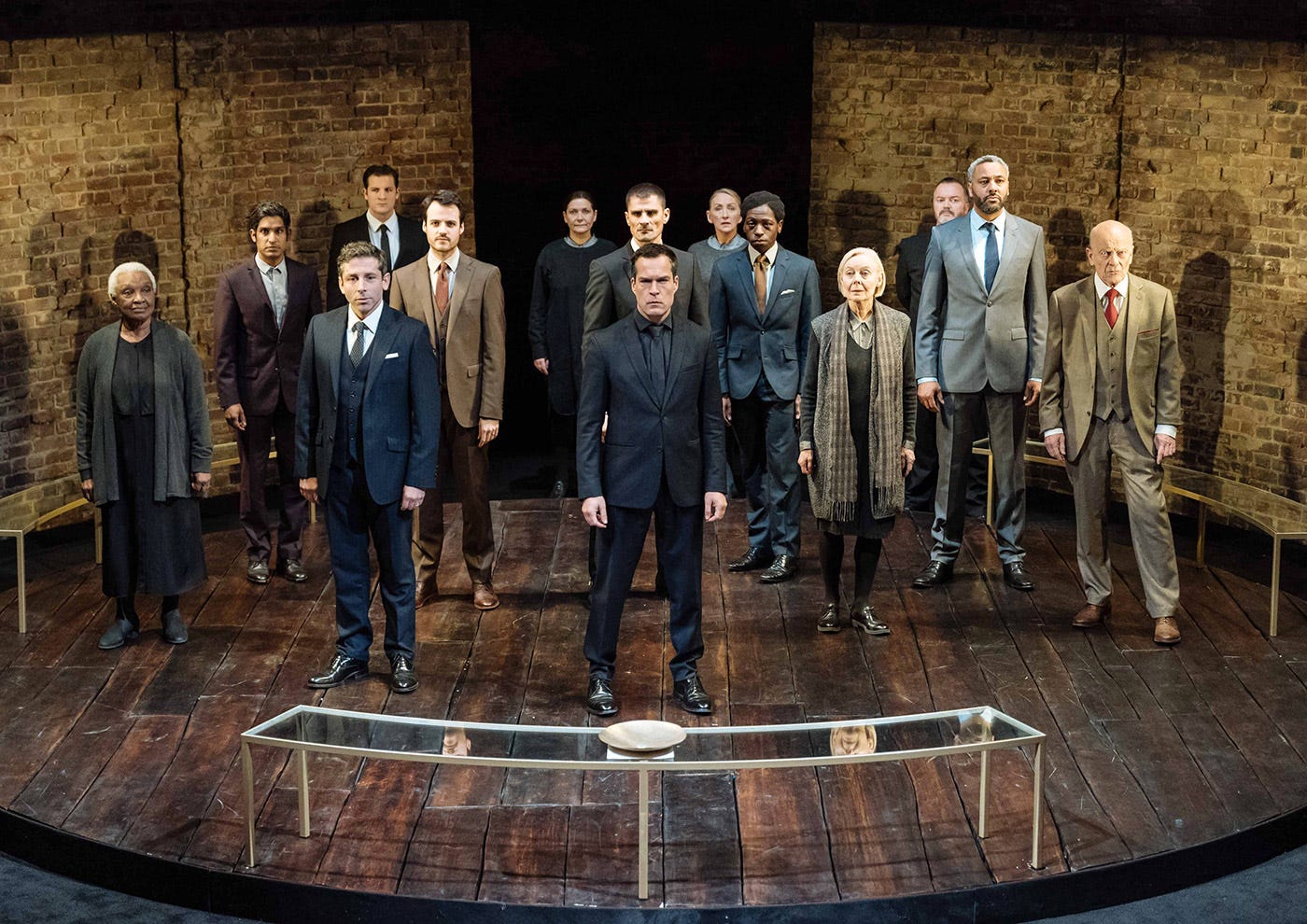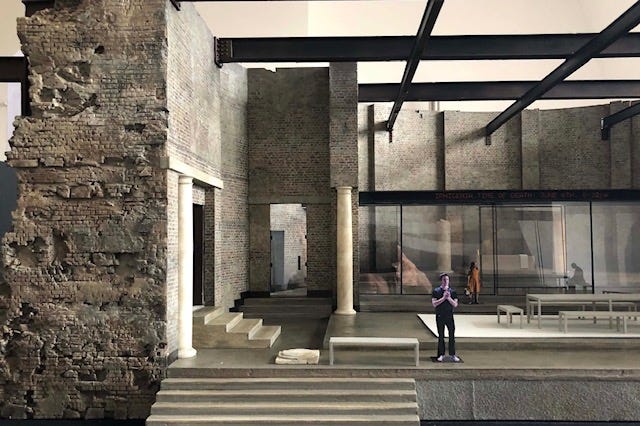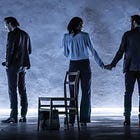Design in focus: an appreciation of Hildegard Bechtler
The third in Rosemary Waugh's ongoing series explores the designer's relationship with Robert Icke - and asks if a building can be a collaborator too
By Rosemary Waugh
The word ‘collaboration’ usually refers to a sustained relationship between two or more people. A playwright and a director. An artist and a writer. An actor and a playwright and a director. Or, in this case, a director and a designer. But what about when those collaborations take on an additional dimension, one that’s connected to a time or a place so strongly it’s as if the non-human elements are themselves another functioning player in the creative marriage? Can a location, a setting or a building be, in its own right, an additional collaborator?
The ongoing creative connection between Hildegard Bechtler and Robert Icke is one of the most noteworthy in contemporary theatre: partly for its longevity (they’ve just completed their twelfth show – Manhunt – together), partly for the quality of the output, and partly because each play stands up individually but also feels like it’s just one piece of an overarching project or ever-expanding idea that is being explored by the pair. What precisely that ‘project’ is, I’ve repeatedly tried and failed to put into words. I wonder if they fully know. I think, for what it’s worth, that it’s something about good and evil, justice, society, unreliable language and the family. Truth, lies, dinnertimes and what we can’t quite see, or don’t want to. Opaque glass, large tables and important horizontal lines.
There’s one other factor which makes this partnership particularly intriguing. Of the productions they’ve created together, five of them (Oresteia, Uncle Vanya, Mary Stuart, Hamlet and The Doctor) were originally created for the Almeida while Icke was an Associate Director at the theatre from 2013 to 2019. Consider that within the wider picture of contemporary British theatre, and how many other creative pairings can you think of that have not only worked together so regularly but done so in one specific theatre with such intensity?
There is, as numerous critics have noted, a certain visual cohesiveness to many of their co-created shows. A crisp contemporaneity grounded in the stylistics of an urban world. There’s that now-you-see-it-now-you-don’t glass that Helen Lewis joyfully christened ‘Hildeglass’ in her introduction to Icke’s Works One. And there are clear geometric shapes found everywhere, from boxy lights to the apportionment of doors, windows and walls. And, most famously, there’s often a digital clock or a video screen of some kind.
Let me stop here and say that the Bechtler-Icke aesthetic is not one that would ordinarily grab me. I would never, for example, live by choice in a house that resembled the settings they have created together. My colour palette is not their colour palette. In fact, I live by choice in an 18th century cottage with black wooden beams and walls painted a shade of aubergine so dark it could backdrop a Rembrandt painting. I actually get physiologically freaked out spending too long inside or near the type of modern architecture seen most frequently on stage in their work. And yet. I also find myself drawn to what they’ve made – moth to flame – like I’m trying to figure out a puzzle of some kind. What does all this, she said waving her hands about incoherently, mean?
The answer is that I find it beautiful. Soothing, even. There’s a clean-lined order and simplicity – despite its conceptual complexity – to these designs. Take, for example, the set for The Doctor (2019, the Almeida) where the curved stone wall of the theatre was concealed by a pale plywood version that had a palpable sense of temporariness or precarity to it. It looked like it was meant to look ‘like a set’: like something impermanent and circumstantial that could fall down with a strong kick. In front of this was – one of those again – a long, strongly rectangular table with spindly legs and benches. You could read into this an echo of the clinical cleanliness of a hospital or other medical setting but it could also have been a very modern church interior – a crucifix wouldn’t have looked out of place at the centre of the back wall – or the lunch hall of a very boring corporate institute.
I feel, firstly, a sense of calm looking at the set for The Doctor and other Bechtler-Icke plays because it’s like someone has, finally, stripped away all the unnecessary bullshit cluttering up a space, a place, a time. But along with this great exhale of ‘Ah, that’s better!’ experienced when gazing upon these sets comes an undercurrent of panic, and this is especially prominent with The Doctor. It’s the anxiety of knowing that, without all the usual ‘stuff’ – literal, metaphorical – to pad it out and cushion the blow, what you are left with is an intense vulnerability to whatever will now play out upon this stage. You know you will feel it. Which is scary and unsettling. It is, in many ways, the visual equivalent of what it is to read the best of Icke’s adaptations of the classics. Writing containing lines that read like once-bloody bones now washed white and clean by sea water.
Bechtler and Icke’s work together began with the Oresteia in 2015, which was meant to be designed be another person who pulled out at short notice. Icke, on his girlfriend’s advice, approached Bechtler, having encountered her work while assisting Thea Sharrock. Since then, it’s become the defining collaboration of this passage of the 73-year-old Bechtler’s career. Prior to this, her insanely prolific working life as a costume and set designer includes opera and theatre credits in so many major theatres across America, Europe and the UK (for example: she’s designed almost 20 shows for the NT’s Lyttleton alone) that it’s difficult to immediately pick out ‘the most important ones’. Her history as a designer does, however, feature another very significant collaboration: one between Bechtler, Deborah Warner and Fiona Shaw, that started with an RSC production of Electra in 1988.
And of course, post-Oresteia Bechtler hasn’t confined herself to solely working with Icke – there has been, for example, that delicious Antony and Cleopatra directed by Simon Godwin in the Olivier in 2020. And neither has Icke exclusively used Bechtler: Bunny Christie was behind the magician’s flourish of a set for The Wild Duck in 2018 and the silky, cinematic The Red Barn in 2016. Nonetheless, their collaboration has easily become a standout feature of both their work over the last decade.
But let’s return to those five shows that were all created for the Almeida between 2015 and 2019. The first thing to consider is that the Almeida is not just any theatre – it’s a space quite unlike most others. When I contacted her for photos for this article, Bechtler referred to the theatre as ‘site-specific’, a term suggesting an especially strong connection between the theatre itself and the work created within it. The Almeida’s dimensions, its atmosphere, its sombre and curvaceous back wall… it’s a place that feels both like a chapel and a cave. A dug-out sensuous space, that could have once contained a sunken Roman bath or Pagan shrine.
All theatres influence the designs that end up on their stages, both in very practical and more ethereal ways. A lack of space in the wings or an unusually high stage or an unchangeable seating arrangement all have immediate repercussions. This aspect of a set designer’s remit – the ability to be brilliantly creative within unalterable parameters and limitations – fascinates me. Placed in the context of the ‘site-specific’ Almeida it becomes yet more intriguing. The immediate question is: could these Bechtler-Icke shows have only come out of the Almeida? Is there something inherently Almeida-y about them that informs not only their physical characteristics but also their creative spirit?
In one sense, the answer is immediately no: Oresteia, Mary Stuart, Hamlet and The Doctor all transferred to other theatres, including ones in the West End, New York, Adelaide, and a selection of regional venues across the UK. Which means they all – to an extent and with some moderations – had set designs that ‘worked’ in spaces other than the Almeida. In fact, when Hamlet and Oresteia transferred to New York’s Park Avenue Armory Theatre in 2022, they actually shared a set which sort of fused together their original ones.
Also, since Icke stopped being an associate at the Almeida, he’s made work with Bechtler for many different theatres, including the Internationaal Theater Amsterdam while he was the Ibsen Artist in Residence and, most recently, London’s Royal Court. One of these times was on Oedipus, which premiered in Amsterdam in 2018, then went to the Edinburgh International Festival in 2019, where it played at the city’s King’s Theatre, and – eventually – arrived post-pandemic at Wyndham’s Theatre in 2024 in a new English language adaptation. Now it’s on track to be in New York at Studio 54 in the autumn of 2025.
The version London audiences saw last year was the same-but-different to the Dutch one, in terms of translating the text, a striking change of cast, and some alterations to the design – the most interesting of which was to make the set move extremely slowly across the stage as the action played out. The subtly of the movement meant it was almost imperceptible to those watching – I never read a reference to this in any London review, although one critic I mentioned this to in person replied that they had noticed – but whether it was picked up consciously, subconsciously or not at all, the concept contains this brilliant slow-motion avalanche echo within it. Time is running out and the ground beneath Oedipus’s feet is almost literally slipping away from him.
Both in its original and altered form, the set for Oedipus was a white-walled office space acting as a politician’s HQ. There’s mismatched furniture, cheap corporate clutter and, in slightly different arrangements, large red-orange floor mats. There is also the suggestion of space beyond the immediately visible room/s, other places only half-glimpsed through doorways or internal windows. The not-quite-back wall of the set is formed from a strong horizontal band of white held up by several white columns and swinging doors. If I sketched it out for you like I was playing Hang Man, the shape on the page would look like a proto-Acropolis or other ancient stone monument.
There’s much about this that looks like a quintessential example of the Bechtler-Icke aesthetic. And yet its suggestion of expansion – it not only looks ‘big’ but also hints at even bigger things just out of sight – makes it different from many of their other works created in the years overlapping Oedipus’s many incarnations. One reason why it contains this sense of vastness is because the set is inspired by the underground spaces at the Lincoln Center for the Performing Arts in New York – including the car parking area – and another is that, although it has since travelled to distinctly different theatres, it didn’t start life in the intense, small world of the Almeida.
Consider instead, the Andrew Scott-starring Hamlet which premiered in north London in 2017. With its row of panelled glass doors forming the background to the stage and its ability to just about reveal things happening beyond the foregrounded space, the set has some overlaps with Oedipus. Yet the Hamlet set – and indeed, production – was never about an excess of space and, by extension, the potential for movement. Quite the opposite: this was a staging in which options may multiply but claustrophobia rules. The theme of surveillance ran through the production, but it was Hamlet’s internal sense of being stuck within his own ever-rotating circles of pain that underlined the feeling of entrapment. Ever dwindling choices pushed the prince closer and closer towards the inevitable.
To return to Bechtler’s use of the term ‘site-specific’. When we use that term, particularly in relation to design, we often assume that to imply a work where the lines between the stage and where the audience sit are blurry and the physical characteristics of the building are integral to how the show looks. Perhaps the work is ‘immersive’ or ‘semi-immersive’; maybe the actors wander among the ticket holders who might be sat, say, in-the-round or in some other formation that runs counter to the proscenium arch model of theatre-watching. Nothing that Bechtler and Icke created for the Almeida was like that. Every set design was in its own way a complete, closed-in world that the audience looked in on, but never stepped within. Indeed, even when the cast from Hamlet broke free from the stage to watch Shakespeare’s play within a play, they stayed so neatly in a differentiated line from the audience that the division between those watching and those being watched was unquestionably maintained.
Yet I imagine that many people who watched Hamlet, or any of those four other shows, would struggle to think of many pieces of theatre more ‘immersive’ (as in: that which completely consumes you) than what they witnessed on that stage. And part of that is because with these Almeida shows, the design of the plays and the theatre they originated in were, in a weird intangible way, in union.
At its best, the Almeida is a theatre that welcomes you to have some kind of a reckoning with yourself. It’s a place where, cut off from the outside world for a brief few hours, you are lost to your own interiority and whatever is happening on stage. Yes, you could argue that’s true of all theatres. But with the Almeida, it’s more so: it envelopes you in bended darkness and you feel both a part of and entirely detached from the other people watching alongside you. The set designs Bechtler created for Icke’s plays in this theatre have the same qualities because they often read like visual metaphors for the segmented psyches for the characters on stage – very much so, in the case of Hamlet – and also like mazes representing the relationships between characters, who are often family members. They are all closed spaces, not bleeding out into the wider auditorium because the Almeida itself is all about going within a closed-off space. And they’re full of hidden secrets and divisions where we pretend there aren’t divisions – because that’s how we relate to each other and how we relate to ourselves.
Manhunt is at the Royal Court to 3 May.
Rosemary Waugh’s book Running the Room: Conversations with Women Theatre Directors is available now. She is currently working on Building the World: Conversations with Women Set Designers, due for publication by Nick Hern in 2026.













I didn't notice the movement in Oedipus! How interesting!